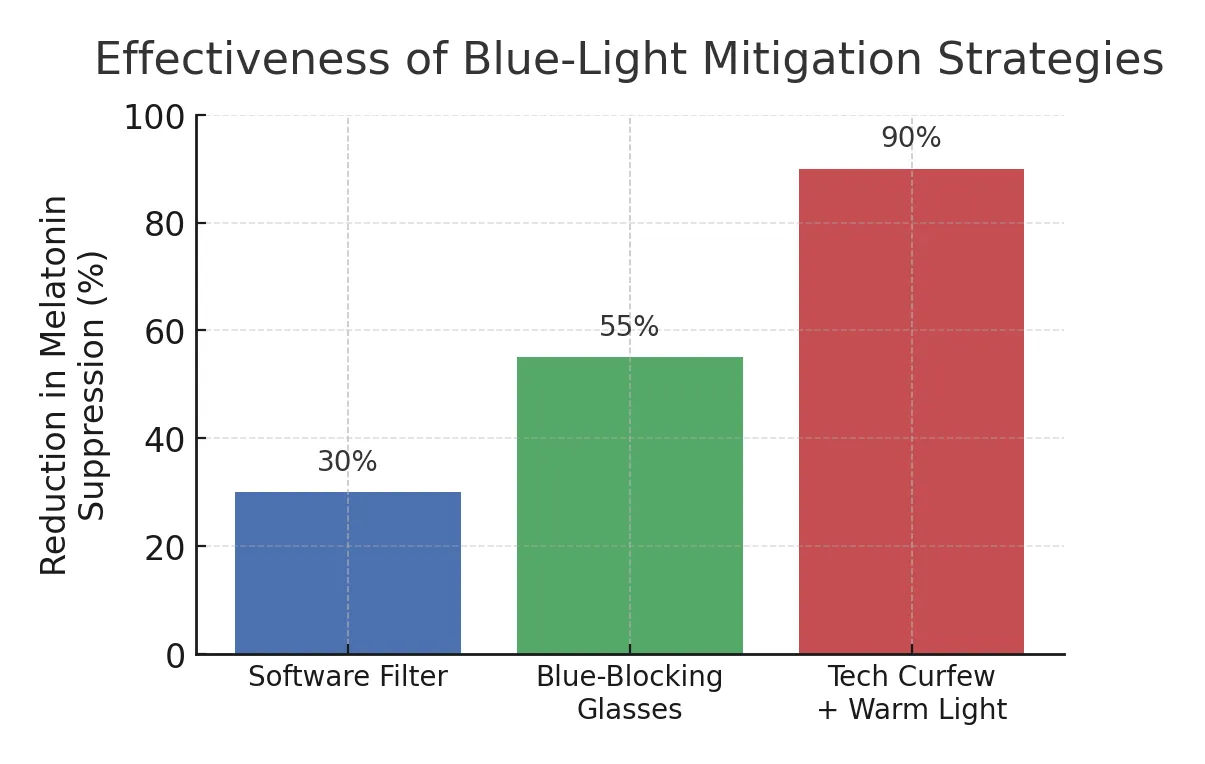Screens Are Here to Stay—But So Is Your Sleep
The average adult checks their phone within 10 minutes of bedtime. Exposure to 460 nm light at that hour can push melatonin secretion by up to 90 minutes (Harvard Med, 2024). Yet nobody wants to live by candlelight in a digital world. Instead of fear‑mongering, this article gives a pragmatic, evidence‑based roadmap to neutralise blue‑light sabotage without ditching every screen.
What Is Blue Light?
Blue light spans 415–495 nm. The human visual system does not treat all colours equally: intrinsically photosensitive retinal ganglion cells (ipRGCs) house the photopigment melanopsin, peaking at ~480 nm. When these cells fire, they send a “daylight” signal to the suprachiasmatic nucleus, suppressing melatonin.

How Blue Light Alters Circadian Timing
An evening tablet session of 100 lux for one hour can delay melatonin onset by ~30 minutes (Heo et al., 2023). The effect is twofold:
- Phase Delay — pushes circadian clock later, making it harder to fall asleep.
- Acute Arousal — suppresses melatonin, raising core body temperature and heart rate.
Short‑wavelength light is especially potent because melanopsin has a long integration time: even brief flashes (<200 ms) add up (Spitschan et al., 2022).
Dose‑Response: Intensity, Spectrum & Duration
A lux × duration × spectrum model explains melatonin suppression. Consider the following matrix:
| Intensity (lux) | Duration (min) | Blue Content | Suppression |
|---|---|---|---|
| 100 | 60 | High (LCD) | ~30 % |
| 50 | 30 | Moderate (OLED) | ~15 % |
| 20 | 15 | Low (Night Shift) | <5 % |
Thus, you have three levers: reduce intensity, shorten duration, or cut spectrum. Combining all three yields exponential benefit.
Tiered Mitigation Strategies
Tier 1 — Software Filters (Easy, Free)
- Night Shift (iOS/macOS) or Night Light (Windows) drops blue by ~45 %.
- Schedule to activate two hours before habitual bedtime.
Tier 2 — Physical Filters (Moderate Effort)
- Blue‑Blocking Glasses — choose ≥ 97 % blockage at 455–485 nm; amber lenses are effective but distort colour less than red.
- Screen Covers — clip‑on filters block 90–95 % blue without changing device settings.
Tier 3 — Behavioural Design (High Impact)
- Tech Curfew — cease interactive screens 60 minutes pre‑bed; swap for print or audio.
- Room Zoning — designate “dark corners” lit by <10 lux amber bulbs for pre‑sleep relaxation.
- Micro‑Habit Stacking — pair dimming lights with brushing teeth to automate routine.
Effectiveness Snapshot

Optimising Home Lighting
Bulb Selection
Choose bulbs labelled ≤ 2700 K for bedrooms and living areas. A 2400 K LED emits 19 times less melanopic lux than a 4000 K LED at equal photopic lux (Heydarian et al., 2023).
Dimming Strategy
Install smart bulbs or wall dimmers; lowering brightness from 100 lux to 30 lux reduces melatonin suppression by ~50 percent.
Layered Lighting
Use task‑specific lamps instead of overhead lighting. For example, an under‑cabinet 20 lux warm LED for kitchen water breaks won’t flood the retina.
Morning Counter‑Punch
Bright morning light >1000 lux for 20 minutes advances circadian phase, partly offsetting inevitable evening screen use (circadian reset guide).
References
Harvard Medical School. (2024). Blue Light and Sleep: What You Need to Know. Harvard Health Publishing.
Heo, Y., et al. (2023). Tablet Use at Night and Melatonin Suppression. Journal of Clinical Sleep Medicine, 19(2).
Heydarian, N., et al. (2023). Melanopic Lux Comparison Across LED Correlated Colour Temperatures. Lighting Research & Technology, 55(5).
Spitschan, M., et al. (2022). Pulsed Blue Light and Melatonin Response. Current Biology, 32(14).